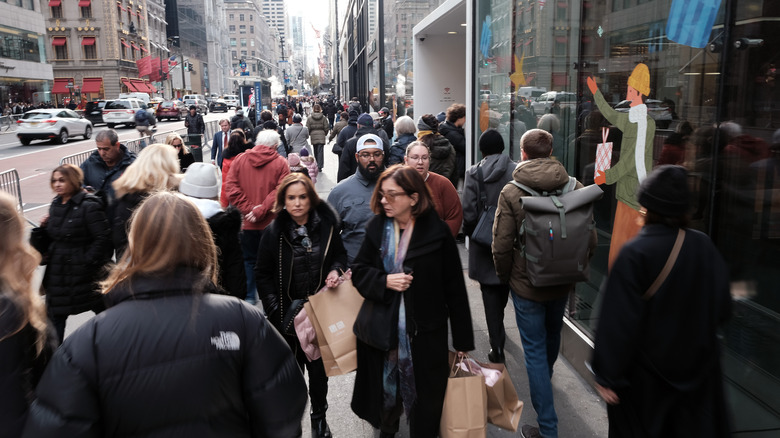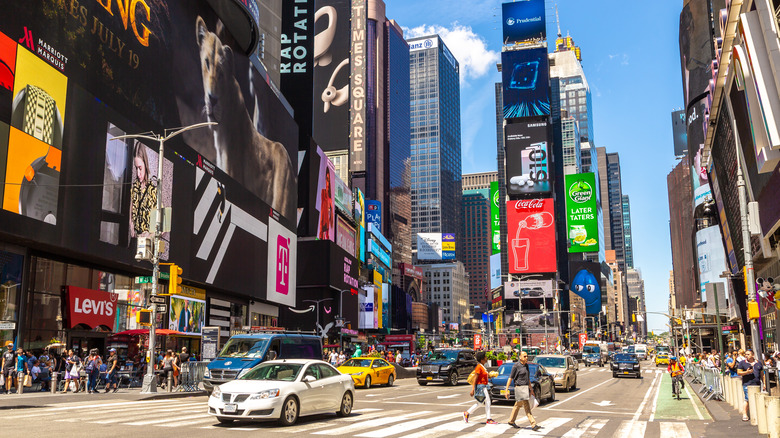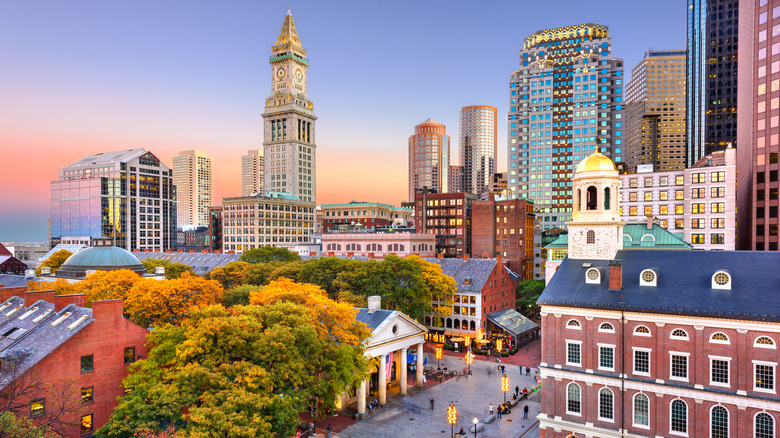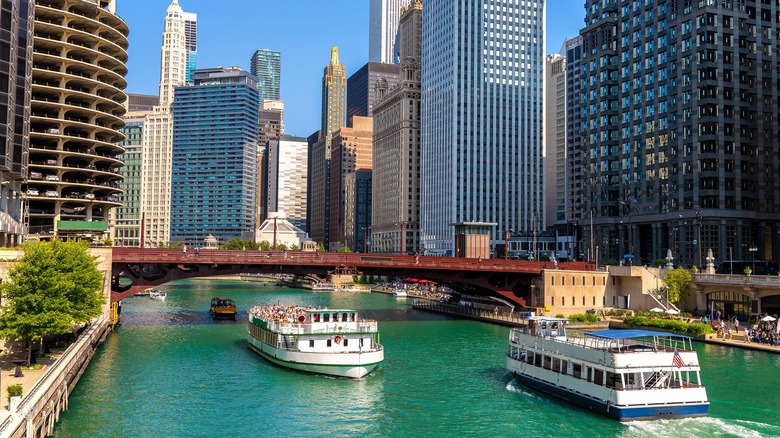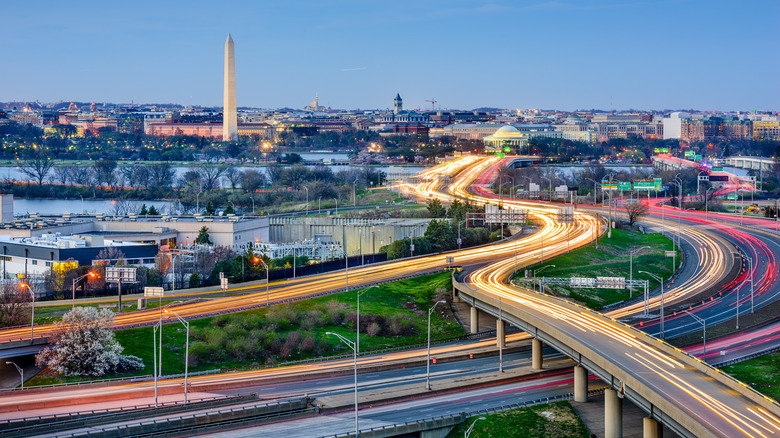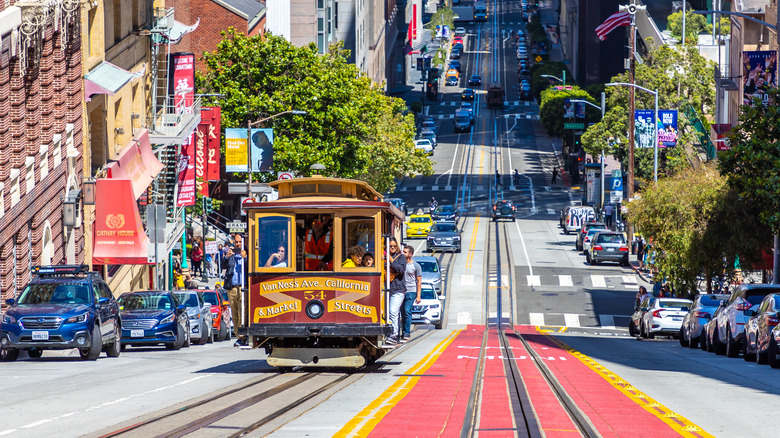The 5 Best Cities To Live In If You Don't Have A Car
Walkability is an important factor considered by renters and buyers of all ages when finding a new place to live. According to the National Association of Realtors, roughly 20% of home buyers surveyed in their 2022 Generational Trends Report listed walkability as a factor contributing to their choice of neighborhood last year. Online real estate marketplaces, like Zillow and Redfin, incorporate walkability into their search algorithms, allowing users to view the walkability score of a home they're interested in. As more buyers consider walkability when choosing a new home, cities should consider how their planning inconveniences carless residents.
There are several reasons to advocate against owning or driving a personal vehicle. However, there aren't many locations around the country that will offer carless residents a simple navigational experience. The United States is known for hosting a plethora of cities plagued by urban sprawl, which is the mass expansion of a city or town often caused in part by strict residential zoning laws, says Britannica. Urban sprawl ensures cities and towns remain car-dependent by distancing commercial resources farther from the communities that need them. As climate activists encourage the public to depend less on fossil fuels and medical experts push for people to exercise more in their everyday lives, walkable cities will continue to grow appealing among all generations, especially those wanting to escape the financial burdens of maintaining a personal vehicle. Here are five of the best cities to live in America if you don't own a car.
New York City
As expected, New York City is consistently ranked one of the best cities for carless residents to live, due to its endless opportunities to walk and its well-funded public transportation options. No matter the borough, you're bound to find sidewalks, crosswalks, and traffic signals catering to the city's many regular pedestrians. While some NYC inhabitants rely on public transportation to get to their jobs, it's common for residents to live within walking distance to a majority of the resources they need on a regular basis. It's easy to find markets, restaurants, drug stores on just about any street in the city.
New York City is also a great place for bikers. The city has over 1,200 miles of bike lanes and routes for cyclists to access, according to Habitat for Humanity. A large downside in moving to New York, however, is the price, as the city is ranked the second most expensive city in the country to live by Luxury Columnist, only falling behind San Francisco, California. However, residents can save costs by utilizing public transportation options that the city has to offer. New York's subway system is one of the most well-known in the world, transporting inhabitants from one neighborhood to the next underneath the hustle and bustle occurring atop the city's streets. This option is far cheaper than taking a taxi or using a rideshare service, and can make for a quicker trip due to the absence of traffic underground.
Boston
Boston is another great option for those wanting to navigate away from a car-dependent society. Boston is much smaller than New York City, housing just over 600,000 residents as opposed to NYC's well over 8 million (via ESTA Form). Living in the city limits gets you close to necessary resources like restaurants and shopping destinations, usually at the expense of higher rent or mortgage payments.
As for public transit, the city offers transportation by commuter rail, water taxi, bus, and ferry, per Boston Discovery Guide. The most popular transportation option among residents, however, is the city's subway, most commonly referred to as the "T." Boston Discovery Guide says the subway is the cheapest way to get around the city aside from walking. On the topic of walking, the city is extremely easy to navigate on foot and is often named one of the best, if not the best, walkable cities in the country, according to The Travel. Surrounded by the Mystic, Charles, and Neponset rivers, Boston also offers many opportunities to take advantage of water transport (via Massachusetts Water Resources Authority). The city's water taxis are used mostly by tourists, but residents can enjoy these resources, as well, along with whale-watching cruises near Massachusetts Bay and duck tours along the Charles River (via Where Traveler). Boston has also implemented a bike share program and trolley system for residents and tourists to utilize, creating even more ways to cut down on carbon emissions within the city.
Chicago
Chicago is another major northeastern city with a large populace, with many travelers migrating from other parts of the country and the world searching for jobs. The Windy City's nearly 3 million inhabitants need to be able to access several methods of transportation to prevent massive pile-ups on interstates and other highway systems (via United States Census Bureau). Sure, many residents who commute to the inner city from the suburbs do so by car. However, Chicago offers several methods of public transportation to get around the city limits and beyond.
Chicago has its own rapid transit system, commonly called the "L" train by natives. According to Free Tours by Foot, the nickname comes from the word "elevated" since a majority of the system's tracks run above ground as opposed to underneath the city. Chicago also has a network of bus routes for the public to use, which travel above ground alongside the city's many cars and taxis. Some residents may need to ride the "L" and use a bus route to reach their desired destination. Chicago is also an ideal location for walkers, runners, and bikers. The city's grid plan makes finding your way around on foot easy. Chicago also offers bike lanes and walking trails as part of an initiative to fund sustainable transportation methods, per City of Chicago.
Washington D.C.
Washington D.C. is a district swarming with politicians, diplomats, judges, and other career-oriented individuals. It's also home to some of the worst traffic in the country once rush hour arrives. Residents of the District of Columbia can certainly navigate the area without relying on a personal vehicle. And for those harboring a phobia of driving or traffic, taking advantage of the city's public transportation options might be a perfect choice.
Many D.C. residents get around on the Metrorail, says Destination D.C., the District of Columbia's official tourism site. Destination D.C. also states that the Metrorail is one of the busiest public transit systems in the United States, serving thousands of residents and visitors each day across the D.C. city limits, Maryland, and Virginia. D.C. is also home to the Metrobus, operated by the Washington Metropolitan Area Transit Authority, or WMATA, for short. These buses run throughout the D.C. city limits, Virginia, and Maryland, as well. In an effort to encourage more residents to utilize public transportation, the city has decided to implement free rides on city buses beginning in the summer of 2023, per DCist. Neighboring the Potomac and Anacostia rivers, Washington D.C. also provides waterfront views and attractions for visitors and residents. Water transport can be found in D.C., as well. D.C. is also kind to walkers and bikers, offering crosswalks, bike lanes, and other handy resources to carless travelers.
San Francisco
San Francisco, known for its stunning views of the Pacific Ocean and its close proximity to Silicon Valley, ranks second among the United States' most walkable cities, says Habitat for Humanity. This city has a lot to offer, from proximity to top-notch universities to delicious restaurants to fun attractions for visitors. San Francisco also has a diverse selection of public transportation options for its residents to use, which could come in handy in a location as expensive as the Golden City.
According to the San Francisco Municipal Transportation Agency, or SFMTA, dwellers of the city can get around on foot, by bike, by taxi or ridesharing service, or via the "Muni," San Francisco's metro system. The city has an extensive network of train, bus, and cable car routes that all operate cohesively, making it easy for residents to navigate the city, whether they own a car or not. Muni is a popular resource in San Francisco, with over 725,000 passengers using the network of buses, trains, cable cars, and street cars daily, per SFMTA. The city's leadership also aims to encourage residents to walk more to decongest city streets. Moving to San Francisco solely to utilize the city's well-developed public transportation system isn't ideal, however. The city is also frequently ranked the most expensive in the United States across several sources. Those already living in the city should take advantage of the many transit options San Francisco offers.
